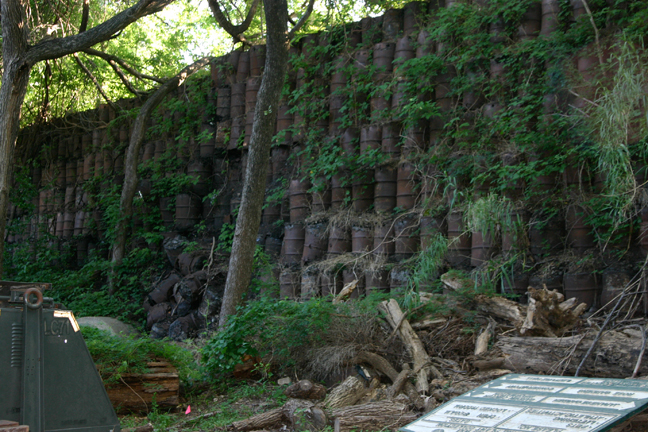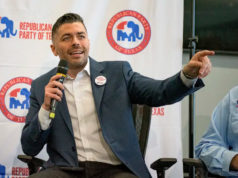A 20-foot retaining wall of unsealed, rusting barrels of industrial waste looms over the western edge of the Fort Worth Botanic Garden, near the site of a planned children’s garden.

For decades, the Trinity Valley Iron and Steel Company dumped foundry slag and sand into thousands of 55-gallon steel barrels and used them to build up the foundry’s sloping property. Now the vacant property is the proposed location of a new rodeo arena.
Though the wall sounds intimidating, the waste in the barrels, according to tests conducted by the city of Fort Worth, does not contain enough lead to be considered toxic by the strict residential standards set by the Environmental Protection Agency. The city tested one barrel and soil in the gardens in 2008 to determine if the waste was contaminating the garden and would affect the garden’s master plan.
In 1997 the Texas Commission on Environmental Quality tested soil and water drainage on the foundry site to see if it was eligible for the state’s EPA superfund. One soil sample showed 866 parts per million of lead, well above the TCEQ’s residential limit of 500 parts per million but still below acceptable levels for industrial areas. The TCEQ report determined the barrels were not leaching hazardous waste into ground water or the soil.
The EPA sets a limit of 400 parts per million of lead for “play” areas where children would have direct contact with contaminated soil. One of the city’s soil samples had 141 parts per million of lead.
How much of a long-term problem the barrels represent still is not clear. The material in the unlidded barrels could escape. However, the waste inside, which has the consistency of porous rock, seems relatively stable. The barrels themselves are less so. Some occasionally fall from their spots on the wall.
Because the barrels are not on city property, the city does not plan to get them removed. Instead, a concrete retaining wall will be built to keep the barrels off garden property. “There’s probably not a problem leaving them there,” said Brian Boerner, director of Fort Worth’s environmental management department. “If we are not seeing any indication [of leaching] right now, my level of concern is low.”
On June 22, the Fort Worth City Council approved an update to the master plan for the garden. The plan includes moving the maintenance area, which currently hides the barrels from public view, to the south side of the garden along I-30. A children’s garden would fill the space left open by the change. The city needs to find between $40 million and $60 million to make those things happen, however.
Members of the garden planning committee initially questioned the safety of placing a children’s garden near the wall of corroding barrels. City staff presented the findings of the 2008 environmental testing to the panel in May.
“The biggest concern was that it was an environmental issue that [the city] would have to deal with first and foremost,” said Leeann Wilhelmi, a member of the Future of the Garden committee. “They’ve had numerous people out there testing the soil, and they’re just not finding that it’s an environmental problem.”
Another committee member said she was reassured by the findings. “Everything has been found to be absolutely and positively safe,” said Barbara Baker, a member of the Texas Garden Clubs.
The city’s 2008 written report, however, called the old foundry site a “brownfield,” which is an EPA term for a property whose expansion or redevelopment may be complicated “by the presence or potential presence of a hazardous substance, pollutant, or contaminant.” These sites are often former industrial sites, like the foundry property.
Wilhelmi said that once the environmental safety factor was taken out, the committee was primarily concerned about the logistics of dealing with the wall of barrels. The barrels are stacked on top of one another without any other restraint, and some have fallen from their 20-foot perch into the garden over the years. The planned concrete retaining wall will be engineered with corrosion and the instability of the barrels in mind, Boerner said.
Even though the wall would put the barrels out of sight, they won’t be completely out of mind. Event Facilities Fort Worth, a nonprofit organization chaired by Ed Bass that is closely affiliated with the Fort Worth Southwestern Exposition and Livestock Show, bought the former foundry property in 2008. For several years the group has been discussing building a new rodeo arena on Harley Avenue, which would include some or all of the former foundry land.
An Event Facilities spokeswoman said in an e-mailed statement that the group “conducted full due diligence on the … property prior to acquiring it, and while it is environmentally stable and in compliance with all regulations, Event Facilities has had under way for more than a year design and engineering of a full mitigation plan.” She declined to explain whether such a plan would include removing the barrels or building around them.
Boerner said he is unsure how the barrels could affect future construction of an arena. “If you removed the barrels as part of the construction, then yeah, they would have to be managed appropriately,” he said.
Appropriate disposal would include testing the waste and sending it to a landfill. Typically, foundry waste, even when not hazardous, is not stored in barrels on private property, said Alfred Spada, a spokesman for the American Foundry Society.
“Proper procedure would not be to fill up barrels and build a wall,” Spada said.
“The disposal techniques were not proper, but just because they didn’t dispose of it properly doesn’t mean it’s hazardous waste,” he said.
Foundry waste must be tested for toxic metals before it can be disposed of. If the waste is deemed unsafe, it is taken to hazardous waste landfills. “If lead gets into the slag, that cannot be put into the ground,” said Fred Kohloff, director of environmental health and safety for the American Foundry Society.
In hazardous waste landfills, toxic metals can still leach out from foundry waste over time, even if the materials were initially safe, said Douglas Kendall, who works for the National Enforcement Investigations Center, a branch of the EPA. Kendall has conducted research on brass foundry waste, which is more likely to contain toxic levels of lead.
“There’s certainly a concern with foundry waste when it’s placed into the ground, and as time goes on, the leaching can spread,” he said. “These metals can leach into the ground and could contaminate drinking water. Plants can take up metals, including toxic metals. If the [concentrations of] metals are too high, the plants aren’t likely to grow.” If plants do grow and are eaten by animals, he said, the toxins could be transferred.
Like Kohloff, Kendall said the main concern about foundry wastes is lead. However, an iron foundry, such as the Trinity Valley was, typically does not produce hazardous waste, Kohloff said. Lead-free foundry sand can be used in other applications, like concrete for road construction.
The Trinity Valley foundry opened in 1924 on nearly 19 acres on Bryce Avenue. McWane Industries, which has a record with the EPA for safety lapses, bought the foundry in 1986 and shut it down in 1988. After demolishing the building in 1990, McWane used the site for storage and leased the land to the stock show for parking.
According to a TCEQ report, the foundry property itself was formerly an industrial hazardous waste site, because it was used as a landfill for furnace dust, which contained lead and cadmium. Foundry workers would fill plastic bags with dust from the furnace used to melt scrap metal and throw them into a 110′ x 110′ pit.
The pit, which backed up to the botanic garden, was cleared in 1985 and filled with foundry slag, like the material filling the barrels.
Despite the foundry’s questionable environmental past, city staffers are confident that though the barrels are corroding, the hardened slag within them is not harmful to the general public.
“If we thought there was any safety concern at all, we wouldn’t put a children’s garden, or anything, near there,” said Veronica Villegas, a city spokeswoman.
After the 2008 testing, the city cleaned up several shovels full of contaminated soil containing elevated levels of arsenic and lead. Environmental director Boerner said the toxins were a byproduct of mixing pesticides and storing decorative pieces containing lead in the maintenance area.
Moving the work area to the south side of the garden has been part of the master plan for decades. Richard Zavala, director of parks and community services, said in an e-mail that the purpose of the move was to open up garden space and limit maintenance traffic through the middle of the garden.
Local architect James Toal designed the garden’s new master plan. He said the western area of the garden along the wall is one of the prettier and more secluded parts of the park. “It’s quiet,” Toal said. “By having the children’s garden there, you don’t have the noise from the highway.”
The planned retaining wall would have to be built even if the rest of the plan isn’t completed, because of the ongoing corrosion of the barrels, he said.
It may be years before Fort Worth residents see any changes to the garden. Toal said that the first project probably will be the loop path, which would connect disjointed parts of the garden. Larger projects, like moving maintenance operations and creating the children’s garden, probably won’t happen for at least four or five years, he said.
In the meantime, the barrels will remain hidden by greenhouses and an employee compound.











